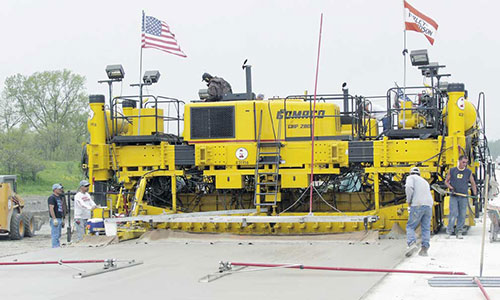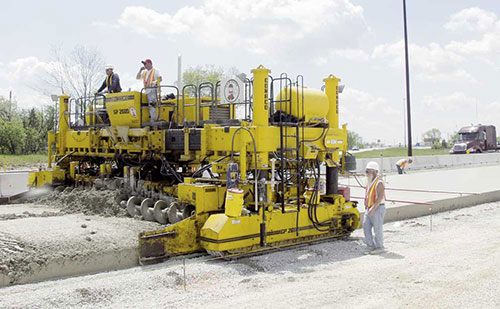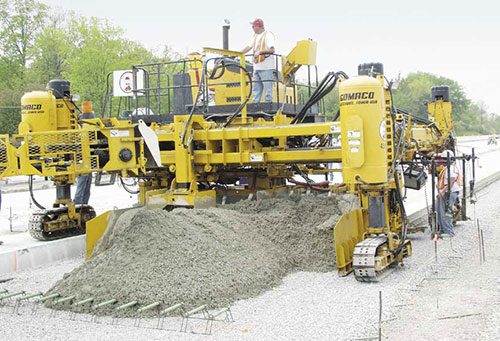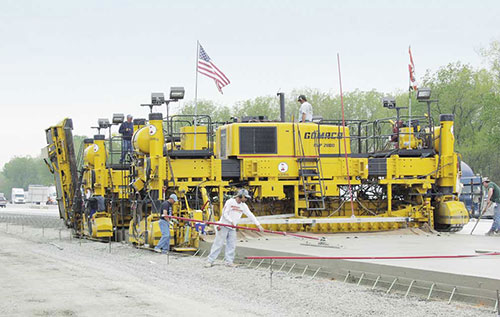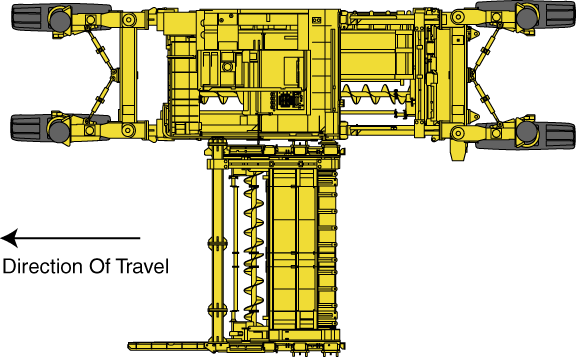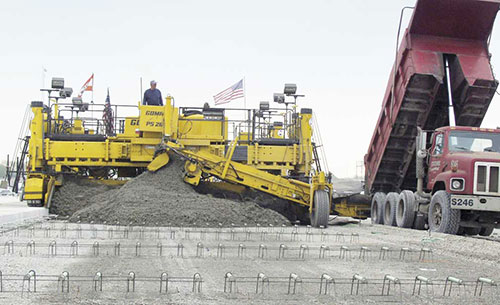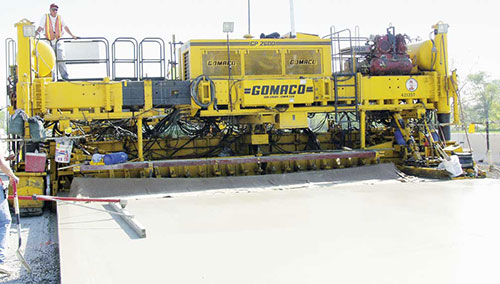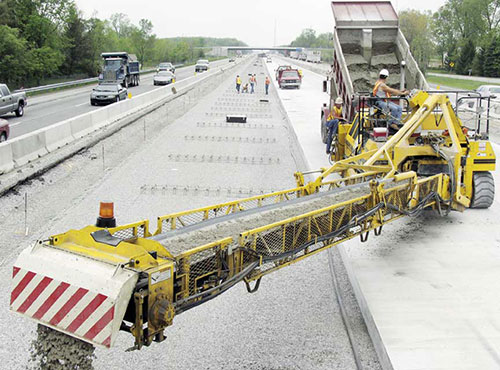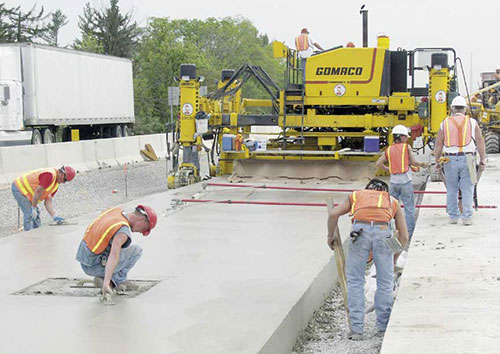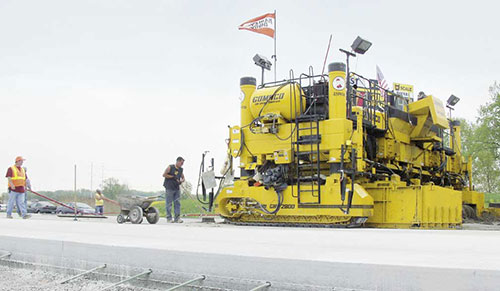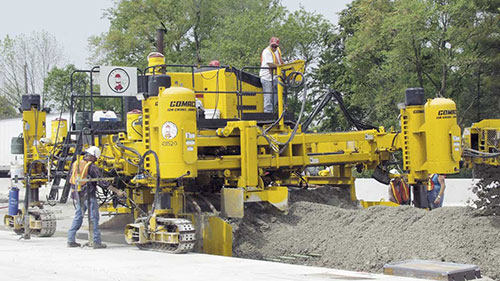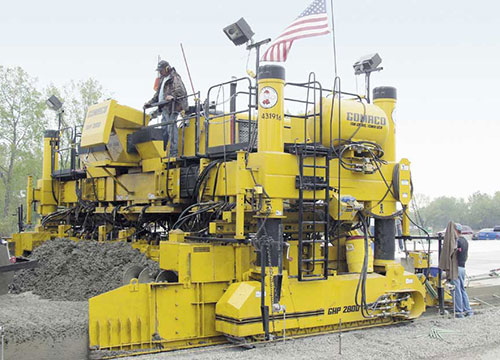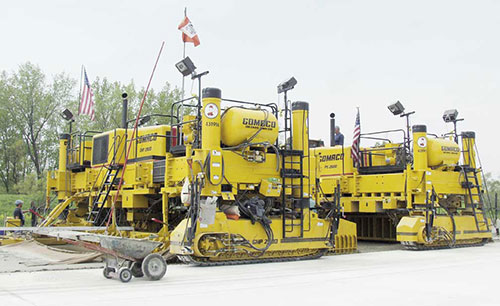GOMACO World Index --- GOMACO World 33.2 - September 2005
Two Project Managers...
Two GOMACO Paving Trains...
Only One Concrete Paving Award
Two projects in the state of Indiana will be among the competitors for the state’s top concrete paving award for 2005. E&B Paving, Inc., is in charge of the concrete paving on two interstate projects and has two of its project managers in friendly competition against each other to bring home the top award. The projects feature both new and older GOMACO equipment.
A new PS-2600 placer/spreader, new GHP-2800 paver and T/C-600 texture/cure machine is at work on the Interstate 80/94 Borman Expressway by Gary, Indiana. On any typical day, the Borman Expressway carries 160,000 vehicles to and from the Indiana-Illinois state line.
The Indiana Department of Transportation has designed the new highway to handle that traffic volume plus more for the next 20 years. The 4.7 miles (7.6 km) of Interstate will be eight lanes wide, four lanes of traffic in each direction, with 12 or 14 foot (3.7 or 4.3 m) wide shoulders.
Baskets are hand-placed on grade every 12 feet (3.7 m) and concrete paving can begin. E&B’s new PS-2600 placer/spreader leads the paving train. A central mix concrete batch plant is located on the east end of the project. Nine end-dump trucks carry the concrete from the batch plant to the placer/spreader.
The new, two-track GHP-2800 paver follows the PS-2600 slipforming the new roadway 24 feet (7.3 m) wide and 15 inches (381 mm) deep.
“This new equipment is working very well for us,” Dave Korba, equipment superintendent for E&B Paving, said. “The new placer/spreader has a faster belt speed and handles the concrete, even if it’s a dry load.
“We like the dual-telescoping feature of our new GHP-2800 paver and the quietness of the machine is just amazing. Production has been good and the smoothness of the slab is very acceptable.”
The state of Indiana uses the two-tenths blanking band to measure the smoothness of their new concrete roadways. The new GHP-2800 is achieving excellent ride.
E&B Paving is at work on two projects in the state of Indiana, the Borman Expressway by Gary (top) and Interstate 69 near Fort Wayne (bottom). They’re using an older style and new style GOMACO paving trains and achieving excellent rideability in challenging conditions.
“We have been doing very well with achieving the incentive pay on this project,” Mark Hayden, concrete paving superintendent for E&B Paving, said. “On the mainline that we’ve paved so far this year, we’ve gotten 97 percent of the incentive.”
A T/C-600 texture/cure machine follows behind the paver applying a burlap drag, transverse tine and spray cure.
The shoulders and ramps are paved with the company’s four-track Commander III. The 14 foot (4.3 m) shoulder on the project is minimum-clearance paving. One side is scabbed onto the new road while the other side runs next to the barrier wall separating the project from live traffic.
E&B decided the easiest way to tackle the minimum-clearance challenge would be to side-mount a 14 foot (4.3 m) mold to their Commander III. By side-mounting the mold, they could still keep a 16 foot (4.9 m) paving mold and kit underneath the machine and not have to switch out molds for the two different applications.
E&B saves time on the project by side-mounting a 14 foot (4.3 m) mold to their Commander III for minimum-clearance paving, while keeping their 16 foot (4.9 m) paving mold and kit underneath the paver. They swing the legs outboard and operate in the transport mode. When they’re ready to pave wider widths, they simply remove the side-mounted mold, swing the legs forward again and resume paving.
“We’ve seen other contractors do this before and we decided to try it,” Dave Korba said. “We lock the Commander III to grade on one side and we’re running slope on the other for the minimum-clearance work. It lets us keep the kit underneath the machine while minimum-clearance paving, and we’ve had really good luck with it.”
Entrance or exit ramps to the new Borman Expressway are slipformed 13 inches (330 mm) thick and 16 feet (4.9 m) wide. The Commander III offers three options for E&B for ramp work. It can be set up in minimum-clearance mode, they can use the V2 hydraulically- adjustable dual mold system, or the standard 16 foot (4.9 m) paving mold to complete the work.
E&B is also at work mainline paving 4.5 miles (7.3 km) of I-69 near Fort Wayne, Indiana, with their PS-2600 placer/spreader, GP-2600 paver and T/C-600 texture/cure machine. They also have one of GOMACO’s first V2 molds. An RTP-500 places concrete in front of the Commander III with V2 mold for shoulder and ramp work.
Mike Korba, project manager/paving superintendent, for E&B’s Fort Wayne project, and his crew are facing some serious challenges. They’re rebuilding the new interstate from the center out so their job site is surrounded on both sides by three lanes of live traffic carrying over 100,000 vehicles per day. The state has allowed them only two entrances/exits on their north and southbound lanes. All construction traffic into and out of the project must use those four entrances/exits.
Concrete delivery and haul routes have to be carefully planned so the trucks can access the placer/spreader and have room to turn around and leave again to head back to the batch plant.
Space inside the project area is so critical, E&B is using a modified concrete mix design to allow a faster curing time. They’ve taken the fly ash out of their mix and are using straight cement to speed up the curing time. Maturity probes are used to monitor the curing rate of the new concrete. In approximately 60 hours time, they can have truck traffic running on the newly slipformed concrete lanes and create some much needed space for maneuvering equipment and haul routes.
“On a project like this, you have to love your job,” Mike Korba said. “I like the challenges, overseeing it all and taking pride in the project as I watch it being built.”
An on-site batch plant produces the concrete mix and slump averages 1.5 inches (38 mm). It’s transported to the job site by 11 end-dump trucks carrying 11 yd3 (8.4 m3) loads. The trucks dump into a PS-2600 placer/spreader which is followed by a GP-2600 paver.
The GP-2600 is paving 26 feet (7.9 m) wide while producing a very unique crown for drainage purposes. The 12 foot (3.7 m) lane has a two percent crown while the 14 foot (4.3 m) lane has a four percent crown.
“Most people wouldn’t do this in a single pour,” Mike Korba said. “I knew we could do it with the GP-2600. We also have a section of roadway with a 5.4 inch (137 mm) super-elevation. We weren’t sure we could do it, but with stringline and the computerized power transition adjuster (PTA), we accomplished the crowns and superelevation without any problems.”
The design of the project doesn’t allow for many long paving runs. It’s short and choppy with a lot of fill in work. Despite all of it, Korba and his crew are achieving good rideability and earning a 90 percent ride bonus.
Achieving good ride in such challenging conditions is based on several factors.
“We’re lucky to have the paving machinery that we have to work with,” Mike Korba said. “You also have to have an excellent stringline crew, good engineers, seasoned help and a good solid track line for the equipment to run on. E&B, as a company, is also very good about listening to employees and any new ideas they may have to improve operations.”
The Commander III with the V2 paving mold is at work slipforming the southbound shoulder. The V2 is GOMACO’s new hydraulically adjustable dual mold that can be used for paving various widths. On-the-go paving of tapered slabs is now possible on all GOMACO pavers.
“With our new V2 mold, I can gain or lose two feet (0.6 m) of paving width in minutes with our operator or ground man simply pushing a button,” Dave Korba explained.
The magic behind the V2 is the dual mold system that can be hydraulically moved and controlled by the operator or a ground man. It is possible to extend the mold on the right side without changing the track line of the paver. The left-hand side is adjustable with the telescoping framework of the Commander III.
A spreader plow on the front of the paver distributes the concrete across the paving width. It also telescopes and automatically makes the same width changes as the Commander III’s framework. The plow has both lateral travel and vertical control that can be controlled manually or set on automatic. Proximity switches on both the left and right-hand side of the plow’s framework set the distance the plow travels across the rail. The right side is equipped with two proximity switches for the different width changes. When a change is made, the operator simply has to reference the outside switch or second proximity switch. As the left-hand side telescopes in and out, that switch simply moves with the framework when the width change is made.
An RTP-500 rubber-tracked placer is feeding concrete in front of the paver which is slipforming 14 feet (4.3 m) wide. Every 250 feet (76 m) the Commander III has to pave over an electrical box set on grade. The boxes have to be set within 0.125 inch (3 mm) tolerance and E&B has to be careful that nothing on the Commander III disturbs or catches on the boxes to bring it out of alignment. So far, they’ve had complete success. Finishers simply go back and remove the excess concrete off the top of the box lid and finish around the edges with hand trowels.
This portion of the project doesn’t require any on-the-go width changes with the V2 mold. They tested that feature out already last year on the Gary project when specifications required the pavement to expand from 12 to 14 feet (3.6 m to 4.3 m) and then back down to 12 feet (3.6 m) again.
“It really saved us a lot of time and all the transitions went very smooth,” Dave Korba said. “We went in and out with the right-hand side while paving on-the-go. After the project was completed, we profilographed the pavement and we felt it did a really good job.”
Once the Commander III with V2 mold has completed its work on the Gary and Fort Wayne projects, it’ll be moved to a rest area project on I-74 near Batesville, Indiana. The project specifications there call for several width changes... a perfect scenario for the V2.
E&B’s work on the Borman Expressway is scheduled for completion in October and Interstate I-69 is scheduled for completion by September 2005. Both project managers are confident they’ll beat those dates.
Editor’s Note: Thank you to the entire crew at E&B Paving for allowing us to visit both your projects and seeing your quality work first hand. Best of luck to both Mike Korba and Mark Hayden on your quest for quality.
Subscribe to Receive GOMACO World Magazine
